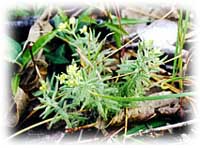
This article relates to the flora of New Zealand, especially indigenous strains. New Zealand's geographical isolation has meant the country has developed a unique variety of native flora. However, human migration has led to the importation of many other plants as well as widespread damage to the indigenous flora, especially after the advent of European colonisation, due to the combined efforts of farmers and specialised societies dedicated to importing European plants & animals.

Sphaerocarpales is an order of plants within the liverworts. Approximately twenty species are in this order which is sub-divided into four families: Monocarpaceae, Sphaerocarpaceae and Riellaceae, as well as the extinct family Naiaditaceae. The inclusion of the Naiaditaceae is uncertain, and the family has sometimes been assigned to the Calobryales.

Sphaerocarpos is a genus of plants known as bottle liverworts. There are eight or nine species in this genus.

Sphaerocarpaceae is a family of liverworts known as bottle liverworts. Approximately ten species are included in this family, most of them in the genus Sphaerocarpos, but one additional species in the genus Geothallus.

Helodium blandowii, also known as Blandow's helodium moss, Blandow's tamarisk-moss, Blandow's bogmoss, and Blandow's feathermoss, is a rare plant in the Western U.S., including Oregon and California. It occurs all around the northern hemisphere in higher latitudes, and in some places is not as rare as in the Western U.S.
Ptilidium californicum, the Pacific fuzzwort, is a rare liverwort of the western United States.

Thelypodium howellii, the Howell's thelypody or Howell's thelypodium, is a rare plant of the Western United States. It is endemic to a relatively small area on the borders of three western States: Oregon, Nevada, and California.

Geothallus is a monotypic genus of liverwort in the family Sphaerocarpaceae family. It includes only the single species Geothallus tuberosus. Its common name is Campbell's liverwort. It is endemic to California, where it is known only from San Diego and Riverside Counties.

Tuctoria greenei is a species of grass endemic to California. Its common names include awnless spiralgrass and Greene's tuctoria. It is included by the California Native Plant Society on list 1B.1. It is also listed by the state of California as rare and by the Federal Government as endangered, having been federally listed on March 26, 1997.

Galium californicum is a species of flowering plant in the coffee family known by the common name California bedstraw.

The flora of Scotland is an assemblage of native plant species including over 1,600 vascular plants, more than 1,500 lichens and nearly 1,000 bryophytes. The total number of vascular species is low by world standards but lichens and bryophytes are abundant and the latter form a population of global importance. Various populations of rare fern exist, although the impact of 19th-century collectors threatened the existence of several species. The flora is generally typical of the north-west European part of the Palearctic realm and prominent features of the Scottish flora include boreal Caledonian forest, heather moorland and coastal machair. In addition to the native species of vascular plants there are numerous non-native introductions, now believed to make up some 43% of the species in the country.

Eremogone ursina is a species of flowering plant in the family Caryophyllaceae known by the common name Bear Valley sandwort.

Ceanothus ferrisiae is a rare species of shrub in the family Rhamnaceae. Its common name is coyote ceanothus.
Pseudobahia bahiifolia is a rare species of flowering plant in the family Asteraceae known by the common name Hartweg's golden sunburst.
Pseudobahia peirsonii is a rare species of flowering plant in the family Asteraceae known by the common names San Joaquin adobe sunburst and Tulare pseudobahia. It is endemic to California, where it is known from a few mostly small occurrences along the southeastern side of the San Joaquin Valley where it rises into the Sierra Nevada foothills. It grows in grassland and oak woodland habitat. It prefers heavy adobe clay soils. The plant became a federally listed threatened of the United States in 1997.

Sphaerocarpos texanus, the Texas balloonwort, is a species of liverwort in the Sphaerocarpaceae family, found in the Americas, northern Africa and Europe.

Thelypodium stenopetalum is a rare species of flowering plant in the mustard family known by the common names slenderpetal thelypody, slender-petaled thelypodium and slender-petaled mustard. It is endemic to the San Bernardino Mountains of southern California, where it is known from only three or four extant occurrences in moist mountain meadows near Big Bear Lake. Its remaining habitat is considered seriously threatened and the plant is a federally listed endangered species in the United States.

Brachiaria mutica is a species of grass known by the common names para grass, buffalo grass, Mauritius signal grass, pasto pare, malojilla, gramalote, parana, Carib grass, and Scotch grass. Despite its common name California grass, it does not occur in California; it is native to northern and central Africa and parts of the Middle East, where it is cultivated for fodder. It was introduced elsewhere and it is now cultivated throughout tropical regions of the world for this purpose.
Lejeunea mandonii, also known as Atlantic lejeunea is a species of liverwort from the Lejeuneaceae family.

Grace Wigglesworth was an English palaeobotanist who published on early land plants, especially bryophytes. She spent over thirty years working as a curator at the Manchester Museum, where she cared for and published for botanical collections in the Herbarium.














